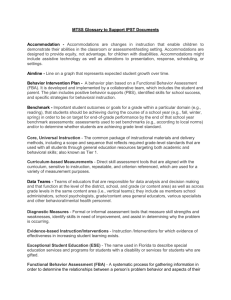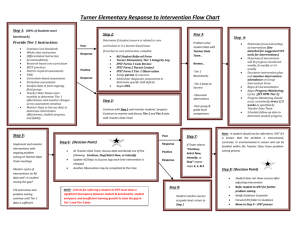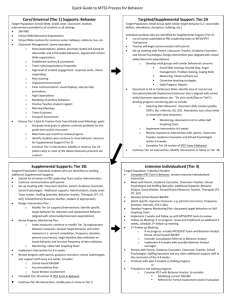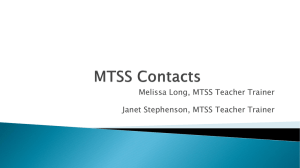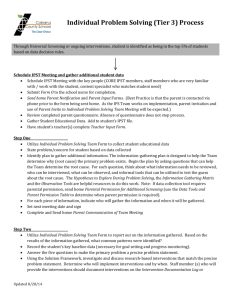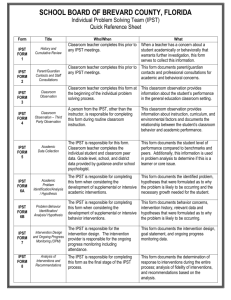Response to Intervention (RtI) Flow Chart
advertisement
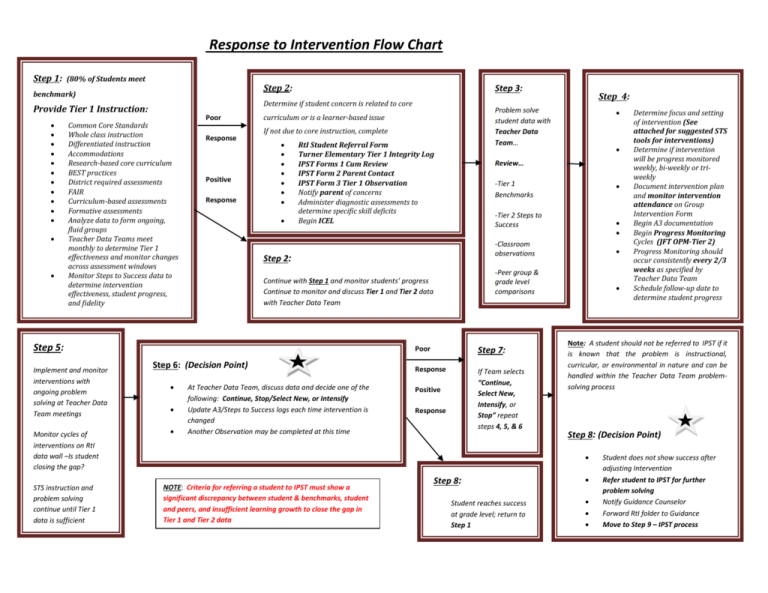
Response to Intervention Flow Chart Step 1: (80% of Students meet Step 2: benchmark) Determine if student concern is related to core Provide Tier 1 Instruction: Step 3: Common Core Standards Whole class instruction Differentiated instruction Accommodations Research-based core curriculum BEST practices District required assessments FAIR Curriculum-based assessments Formative assessments Analyze data to form ongoing, fluid groups Teacher Data Teams meet monthly to determine Tier 1 effectiveness and monitor changes across assessment windows Monitor Steps to Success data to determine intervention effectiveness, student progress, and fidelity Poor Response Positive Response If not due to core instruction, complete RtI Student Referral Form Turner Elementary Tier 1 Integrity Log IPST Forms 1 Cum Review IPST Form 2 Parent Contact IPST Form 3 Tier 1 Observation Notify parent of concerns Administer diagnostic assessments to determine specific skill deficits Begin ICEL Monitor cycles of interventions on RtI data wall –Is student closing the gap? STS instruction and problem solving continue until Tier 1 data is sufficient At Teacher Data Team, discuss data and decide one of the following: Continue, Stop/Select New, or Intensify Update A3/Steps to Success logs each time intervention is changed Another Observation may be completed at this time -Tier 1 Benchmarks -Tier 2 Steps to Success Continue with Step 1 and monitor students’ progress Continue to monitor and discuss Tier 1 and Tier 2 data with Teacher Data Team Step 6: (Decision Point) Review… Step 2: Step 5: Implement and monitor interventions with ongoing problem solving at Teacher Data Team meetings Problem solve student data with Teacher Data Team… curriculum or is a learner-based issue Step 4: -Classroom observations -Peer group & grade level comparisons Poor Step 7: Response If Team selects “Continue, Select New, Intensify, or Stop” repeat steps 4, 5, & 6 Positive Response Note: A student should not be referred to IPST if it is known that the problem is instructional, curricular, or environmental in nature and can be handled within the Teacher Data Team problemsolving process Step 8: (Decision Point) NOTE: Criteria for referring a student to IPST must show a significant discrepancy between student & benchmarks, student and peers, and insufficient learning growth to close the gap in Tier 1 and Tier 2 data Determine focus and setting of intervention (See attached for suggested STS tools for interventions) Determine if intervention will be progress monitored weekly, bi-weekly or triweekly Document intervention plan and monitor intervention attendance on Group Intervention Form Begin A3 documentation Begin Progress Monitoring Cycles (JFT OPM-Tier 2) Progress Monitoring should occur consistently every 2/3 weeks as specified by Teacher Data Team Schedule follow-up date to determine student progress Step 8: Student reaches success at grade level; return to Step 1 R Student does not show success after adjusting Intervention Refer student to IPST for further problem solving Notify Guidance Counselor Forward RtI folder to Guidance Move to Step 9 – IPST process Challenger 7 Elementary IPST Flow Chart Step 9: Step 10: The Teacher will gather appropriate paperwork including but not limited to: The Guidance Counselor will: A3 data Intervention logs Progress monitoring data Report cards Formative assessments Curriculum based assessments IPST Form 5 is completed Step 11: Schedule a meeting with Teacher to review Forms 1-5 and advise of any additional required forms that need to be completed Schedule IPST meeting Notify team via email of IPST meeting date Update parent that student is moving onto IPST process and will be notified of future teacher-parent conference date to discuss IPST recommendation Arrange classroom coverage for teacher attending meeting IPST meeting occurs and Team reviews: IPST Forms 1 through 5 RtI data ICEL – Form 6 IPST Problem Solving Team confirms and concludes: Gap in Tier 1 data from student to peers Gap in learning rate in Tier 2 data Collects behavior data if necessary Gathers more data if necessary Determines if Tier 3 interventions are warranted or student is ready for eligibility ICEL – Form 6 Team generates: Hypothesis and Goal Statement Bases Tier 3 intervention design from goal statement IPST Form 7 OPM Data Collection Form Team determines follow-up date to review Tier 3 progress Teacher notifies parent to set up conference to discuss results of IPST recommendations Step 12: (Decision Point) At IPST follow-up meeting, Team assesses: Tier 3 intervention fidelity and progress Decides to: Move student to Tier 2 or Tier 1 o (Repeat Steps 38) Continue Tier 3 o (Repeat Step 12) Determines outcome Complete IPST Form 8
